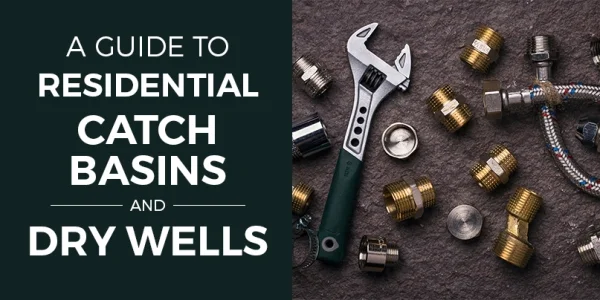
Table of Contents
- What Is a Residential Catch Basin?
- What Is a Residential Dry Well?
- Where and How Are Catch Basins and Dry Wells Used?
- How Do I Know If I Need a Residential Dry Well or Catch Basin?
- What Can Go Wrong With a Catch Basin?
- What Can Go Wrong With a Dry Well?
- Tips for Dry-Well Maintenance
The plumbing systems of any home encompass elements that do the important jobs of conducting household water and waste. Systems include nearly any appliance or utility that concerns water and in some cases, other liquids:
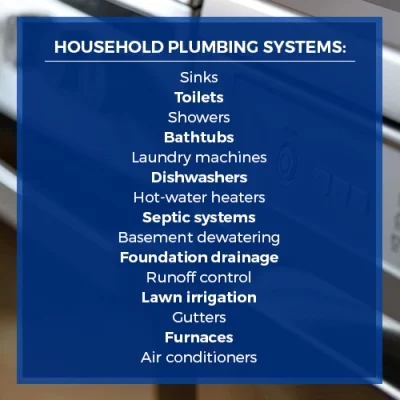
We tend not to think often about the drainage systems of a house since their workings are mostly unseen, but they remain essential to the good functionality of nearly everything else inside and outside the house. Failing or ineffective drainage can cause everything from minor irritation and annoyance to major expense and repair.
Residential drainage systems often feature outdoor catch basins and/or dry wells, so a solid understanding of what they are and the jobs they do can be beneficial.
It is not unreasonable to expect a mostly carefree drainage system, but it requires a commitment to and investment in proper installation, maintenance, and service. A thorough knowledge of the system in place, along with regularly scheduled checks and maintenance, will achieve a smooth-running system and prevent failure as well as the need for repair.

While it is public systems that seem to be better understood, private water, waste, and drainage systems contribute to the overall water picture and should also be understood and attended to. Knowing the different uses for a catch basin vs. dry well serves as a benefit to nearly anyone since both utilities exist in a number of residential conditions and can provide solutions to a number of drainage issues.
They exist in both rural and urban settings within environments that may be challenging due to steep, sloping or lowland terrain and soils that are rocky, dry, saturated or mineral-heavy.
Though they are different utilities, nearly all kinds of catch basins and dry wells have at least five major things in common:
- Both convey water away from your property
- Both work by gravity
- Both typically have a grate and drainage components
- Both can alleviate a number of home headaches such as flooding and standing water
- Both involve a system of pipes to conduct water and a place to temporarily hold it.
Depending on people’s preferences or current situation, either kind of drainage aid can be used to catch and process water that runs off the roof, driveway, patio, porch, deck or lawn, as well as used water from the household such as from laundry, dishwashing, bathing and septic water from which solids have been filtered.
The main difference between the two kinds of drainage utility is that by definition, a catch basin has a water-tight underground container while a dry well is normally a permeable hole in the ground. This article answers some commonly asked questions about catch basins and dry wells.
What Is a Residential Catch Basin?
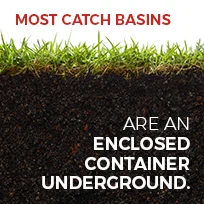 Generally, a catch basin is a drainage system designed to carry water away from your home and perhaps direct it across the property before it runs to a public storm-water system, dry well, local water body or into the ground. A catch basin can take many forms, but it’s common to see some kind of grate over an angled inlet, often with an in-ground concrete or plastic basin that catches the water. From there it may be pumped out and released elsewhere, routed via subsurface pipe to a release location or allowed to evaporate.
Generally, a catch basin is a drainage system designed to carry water away from your home and perhaps direct it across the property before it runs to a public storm-water system, dry well, local water body or into the ground. A catch basin can take many forms, but it’s common to see some kind of grate over an angled inlet, often with an in-ground concrete or plastic basin that catches the water. From there it may be pumped out and released elsewhere, routed via subsurface pipe to a release location or allowed to evaporate.
Some utilities called a catch basin may have an open design, but most are enclosed containers underground. A catch basin is usually situated at a low point of the property and will have some type of drainage pipe or other conduit attached that slopes away from the basin itself.
The catch basin might do any combination of functions such as catch, hold and filter the runoff water from the lawn, around the house, off surfaces and out of the gutters. You can find catch basins in homes and businesses that use both public and private water conveyance systems.
In a residential setting, the catch basin might be a 12-foot by 12-foot square box sold at home improvement stores for about $51, or like its public-sector counterparts, it can be a much bigger structure made of concrete or lined concrete blocks. The price of a bigger catch basin would of course be more than the small, premade type, but the cost would depend on the structure’s size and the going rate of materials. Catch basins might also be made of reinforced concrete or polypropylene that has perforated sides and bottoms.
The size, structure type and other specifications for a catch basin depend largely on what kind of water it will receive and how much of it. For example, the catch basin for a big parking lot would likely be made of concrete with a large metal grate and be located directly underneath the surface that drains to it. There are also cases where a water pump helps to redistribute the water in a catch basin, depending on what kind of water it holds and where it can be routed to from the basin or well.
What Is a Residential Dry Well?

Simply put, a dry well is used for the drainage of water from a property, but the water can be storm-water runoff from the roof and paved surfaces, septic-tank water from which the solids have been filtered or used water from the shower, laundry, dishwasher and sinks.
Like a catch basin, a dry well might also collect rainwater runoff from gutters and other impervious surfaces around homes and businesses such as the driveway, patio and walkways, and other areas. Dry wells take many forms and can serve a variety of purposes in household drainage, and it’s possible to see them used in conjunction with a catch basin or to see more than one used on a single piece of property.
Dry wells, which may also be called seepage pits or leaching pits, are typically dug somewhere near the lowest point of the home site and reinforced with rocks, stones, gravel, brick or concrete. It is normally an underground hole with some type of grate or covering over the top. Runoff water flows to and into the well, and then the soil in and around the hole absorbs and somewhat filters it.
People sometimes mistakenly call a dry well that receives water from the septic system a cesspool, but a cesspool involves raw sewage whereas a dry well does not. You may hear this type of water referred to as the septic “effluent,” which may also include water from dishes, bathing and laundry.
The water usually runs to the dry well through an underground pipe, but sometimes, it may flow over the grass to get to the well, which builds in another step of natural filtration. Once in the well, the water runs through the rocks, stones, gravel, brick or concrete, which provide filtration.
If the system is not functioning properly and the water bypasses this natural filtration system, it will convey to nearby waterways unwanted particulate matter from the roof, driveway and other areas including water from the septic system. Wherever they are unintentionally or inadvertently deposited, those contaminants can then adversely affect plant and animal life, influence water-body temperatures and compromise soil health.
Dry wells can be filled with gravel, concrete, rubble, stones, brick-and-mortar or another kind of rock that not only provides natural filtration but also reinforcement against collapse, and the hole is usually six to eight feet deep and four to ten feet square or round. 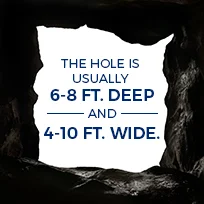 The depth and diameter of the dry well depend on how much and what kind of water you want to convey, how often it will come, the percolation rate of the soil around it, the slope and several other factors.
The depth and diameter of the dry well depend on how much and what kind of water you want to convey, how often it will come, the percolation rate of the soil around it, the slope and several other factors.
Still, many residents like the idea of having a dry well for certain parts of the plumbing system to augment an aging septic system or to alleviate flooding on the lawn or other outdoor areas. Some people don’t need much volume and want a simple, small pit filled with gravel or rock. Other homeowners want to be prepared for the worst and have a dry well that handles a large volume of water and can then slowly release it back to the earth and groundwater.
Where and How Are Catch Basins and Dry Wells Used?
A catch basin and/or a dry well may be used in many kinds of residential as well as public-sector settings on large and small scales. They are utilities that seek to convey, hold and distribute water in the most desirable way rather than let it sit in or flow to places it should not be, where it usually causes some kind of damage or other unwanted issues.
Houses exist in all kinds of configurations and orientations that give their families challenging drainages, inc
- At- or sub-grade windows
- Basement or cellar
- The underside of decks and porches
- Gardens
- Garages
- Limited-capacity septic
- Remote plumbing fixture
- Slopes and hills
You may find a catch basin or dry well in place to help the septic system leach field from which water drains. As these waste-disposal systems age and environmental conditions around them may change, they can develop problems in parts of the leach field or may just be old enough that their ability to process the water has diminished over time.
It’s usually a good idea to consider the replacement of a system that for whatever reason cannot properly process the liquids from the septic system that drains to the leach field, but in some cases, a dry well can help manage excess septic system water.

Either utility can also provide a means to take the dirty water from a plumbing fixture such as a sink or washing machine that is far from the main septic system. In some remote cases, it makes more sense to construct a separate drainage system than to try and route an underground line to the existing septic pipes.
Many old and new-construction homes incorporate one or several dry wells or catch basins in order to encourage good drainage on the property. Both utilities can effectively address a range of different conditions, including a terrain that just doesn’t drain well and might have patchy turf, moss or saturated areas.
How Do I Know If I Need a Residential Dry Well or Catch Basin?
You and any other homeowner or resident know their property better than anyone else, and there are some signs that may indicate you need supplemental or improved drainage:
- Is there standing water in your yard or near your property regularly?
- Do you have concrete, steel or other impermeable materials edging the yard?
- Does the grass stay saturated?
- Are parts of the lawn dead?
- Are there foul odors in certain spots?
- Do you see excess insects, mosquitoes in particular?
- Is the terrain of your yard or neighborhood sloped?
- Does water accumulate in the basement or garage or other areas after a heavy rain?
- Is there any mold or mildew on the interior or exterior of your home?
The presence of any of these conditions can be helped and often solved with a correctly sized catch basin and/or dry well. Any of the issues caused by poor drainage can be annoying, and many are even concerning since water can damage property.
What Can Go Wrong With a Catch Basin?

The most common problem with catch basins is that debris accumulates on or in them over time, which slows or stops drainage, produces bad smells, causes flooding and might incur costly repairs if the clog causes some kind of failure or backup.
One way to prevent unwanted scenarios and catch-basin repairs is to clean the catch-basin grate regularly and to check it after heavy rains. Most people prefer to have this done for them, and professional, licensed plumbers like we have at Mr. Rooter of Greater Syracuse can help to locate and assess your catch basin, which then gives you the information you need to set a catch-basin maintenance schedule.
To some extent, immediate environmental conditions affect the condition of a catch basin. For example, you should consider:
- Size of the household using it
- The terrain in which it sits
- What kind of soil is around it
- Amount of rain a place gets annually
These are all factors that matter as you make catch-basic maintenance decisions. It also helps to consult a professional to make sure the basin is properly sized and installed as well as functioning properly.
Some parts of a catch basin, mainly the underground pipes and water receptacle, are unseen but can be assessed for proper performance both by above-ground observation, evaluation of system performance, and by subsurface inspection using a tiny camera, the plumbing video camera. Cracks, leaks, clogs and crumbling concrete can send water to places you don’t want it and create problems in other areas, which makes regular maintenance and service not just a measure for peace of mind, but also for proactive problem prevention.
What Can Go Wrong With a Dry Well?
Many problems can occur with a dry well depending on the conditions, but some of the common ones that may cause dry-well repair are listed here:
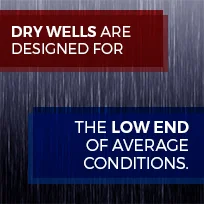 Like in the catch basin, a buildup of leaves, sediment and other assorted materials inhibit or prevent the function of a dry well, and that is when the bigger headaches can come in the form of flooding, damage, standing water, foul smells and even dangerous bacteria.
Like in the catch basin, a buildup of leaves, sediment and other assorted materials inhibit or prevent the function of a dry well, and that is when the bigger headaches can come in the form of flooding, damage, standing water, foul smells and even dangerous bacteria.
- One of the common problems with dry wells is they are undersized for the job. Dry wells are typically designed for a minimum-type rain event or the low end of average conditions, so it is easy for a sustained, soaking rainfall to overwhelm small systems, much less a huge storm. It’s also not unusual for homeowners to add impervious surface to a property and not realize it adds water volume to the drainage that the original dry well may not be designed to handle.
- Ideally, all dry wells and catch basins should be designed to withstand the worst storm or flooding anyone has ever seen outside of catastrophe conditions, but realistically, most are not designed to that standard because of economics. The sizing of the structure matters, and if a well or basin continually performs below your expectations, it is probably too small for the property conditions.
- If the place you live has a high water table or gets a lot of rain, the water can back up when a dry well is undersized or the drainage has become inhibited. It is also easy to misgauge the amount of water a family uses, which is an important number when figuring out how big of a drainage utility you need.
- The kind of soil around the dry well and what the backfill dirt consists of make a big difference in how the utility will perform because if the drainage of either material is not sufficient, it hinders the water-leaching process. That may leave you with standing water, a breeding ground for bacteria, mosquitoes and foul smells.
- Under certain circumstances, pieces of accumulated debris could potentially make their way into other parts of the overall plumbing system. Another reason to clean a dry well and its parts regularly is that when enough sediment flows into the dry well, it will begin to leach into the surrounding soil and affect the well’s capacity to filter and drain the water. When built-up sediment within a dry well is left too long, it will eventually degrade its performance and cause failure, even if the utility was sized and installed correctly.
- Wall wells can collapse when they do not have the proper structural support or when that support shifts or is removed. There have been many cases where homeowners think it’s a good thing to remove the concrete, rock, brick gravel or stone in the well hole when in actuality, the well needs some of that material to help support the walls and prevent collapse. It can be a tricky balance to not only choose the right materials for effective well drainage but also the right quantity and arrangement of those materials.
Tips for Dry-Well Maintenance & Catch Basin Upkeep
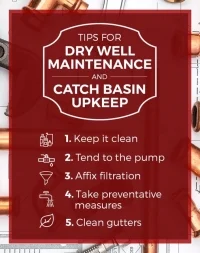
There are a number of measures that will help keep your dry well or catch basin functioning properly:
- Keep it clean: While a well-functioning dry well will catch all the runoff properly, the water will always bring dirt, asphalt particles, vegetation and other assorted materials with it. One key to good function is to clean out the dry well or catch basin periodically and check and clean the grate often, like after every big rain and almost daily when leaves are falling. How often you need to have it cleaned depends on how fast debris accumulates, which to some extent depends on each individual property and its terrain.
Usually, an annual or semi-annual inspection and maintenance plan is sufficient for average situations.
Most people prefer to have a professional perform the cleaning task. Nobody enjoys pulling out the mystery wads of debris that are impeding drainage, and a licensed plumber has the expertise to make sure the dry well’s structure and parts are in good condition and the proper tools. Sometimes the walls of the well can get so gunky that thorough draining and cleaning is needed before correct drainage can resume.
A good, general maintenance practice that everyone can do themselves is to keep any visible parts of the system such as the trap and grate free of debris, especially leaves in the fall. Leaves can effectively cover the entire surface of the utility and cause the water to fully bypass the grate or cover and then flow to places it should not.
- Tend to the pump: Your dry-well setup may include an existing pump that has malfunctioned, or you may have to use a pump to remove water in order to find and fix problems. Especially since pumps and their installation can cost as much as $2,500, people like to consult a professional to get the job done right.
- Affix filtration: The drainage and flow utilities cannot function properly when the grates become clogged or the debris and sediment build up to the point of flowing along with the water. The point is to catch those things and prevent them from traveling to the municipal system or a nearby water body and from backing up into parts of your system. In cases where a dry well will manage used water from laundry facilities, a lint filter can be installed to keep material from entering and building up on the well interior.
- Take preventative measures: The City of Syracuse, for example, warns people not to dispose of fat, oil or grease, or fog, down the drain or through any drainage system since it will cause system clogs. People are advised to remove as much of the materials from dishes as possible and then throw it in the trash before washing or running dishes through the dishwasher.
The “fogs” come in the form of many things we don’t typically think of as direct forms of fat, oil or grease, such as butter, gravy, shortening, meat scraps in the disposal, salad dressing, pastry and fried foods. The city-states that just one teaspoon of fat kept out of one drain each day prevents a total of 12 pounds of fat, oil or grease per year from running to and through both public and private systems, where they cause clogs and do damage.
Even systems with good installation and function can be degraded over time with the fog, as well as soap scum, residuals from fabric softener and detergents, laundry lint and particles from the roof and patio. These materials are a little less obvious than leaves and vegetation, but they can be equally as harmful if allowed to accumulate. These facts support the logic of regular inspection and cleaning of dry wells, catch basins and septic systems.
- Clean gutters: The more leaves, sticks, dirt, asphalt particles and other debris you can keep out of the gutters, the less that material will flow to the dry well or catch basin. You can also use gutter guards or screens to keep waste out of the water that flows to the catch basin or dry well.
Good maintenance will prevent you from having a costly repair bill that can potentially involve water pumps, excavation and new mortar or concrete. The cost of an annual or semi-annual professional inspection is small compared to what any one of the bigger projects or major services could cost, such as a catch-basin replacement.
Residential Dry-Well Installation & Repair
It’s pretty common for people to endeavor all kinds of do-it-yourself projects around their homes, sometimes to save money and sometimes because they just enjoy the improvement to their standard of living. However, the drainage around a house such as a catch basin or dry well is truly complex, and usually professional help is advised if not required to complete the tasks involved.
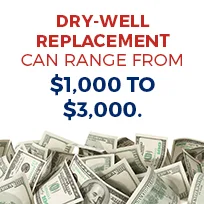 Dry-well replacement can cost in the range of $1,000 to $3,000. It is something to get right because even a slight imperfection in the slope of the pipe or an incorrect fitting can make the dry well lose effectiveness. An average homeowner might not know that a catch-basin outlet needs a minimum of a three-inch-diameter pipe as well as a down-facing elbow or T-joint to discourage clogging.
Dry-well replacement can cost in the range of $1,000 to $3,000. It is something to get right because even a slight imperfection in the slope of the pipe or an incorrect fitting can make the dry well lose effectiveness. An average homeowner might not know that a catch-basin outlet needs a minimum of a three-inch-diameter pipe as well as a down-facing elbow or T-joint to discourage clogging.
Not everyone will realize the well’s location relative to the water table will affect its performance and can mean the difference between it back up or not. The system should be correctly sized to handle large volumes of water, and the choices of piping material will usually be corrugated or smooth. While smooth usually costs a bit more, it reduces the chance corrugated that debris will stick, cause a blockage and prevent the water from flowing as it should.
Proper installation can also be a matter of law as neighbors, municipalities, counties and states grow increasingly more focused on clean-water legislation under the federal Clean Water Act. It is common for cities, villages and towns to have laws or be considering laws that mandate inspections of catch basins, dry wells and other private utilities, which all contribute to the overall drainage in an area.
Where the water comes out and what it contains is a matter of great importance, and people can be held responsible and penalized for a non-conformant system that negatively affects groundwater, water bodies, neighboring properties or public systems. Most good guidelines and now ordinances aim to ensure that the water of a dry well or catch basin is routed and released correctly and that the proper-sized pipe is used to connect a catch basin or dry well to the various things draining to it.
The law often requires certain clearances, components, and specifications for various drainage systems, and the person installing should be aware of the soil absorption rates, the strength of various materials used, and how much capacity is needed to accommodate the characteristics of a property.
Residential Catch-Basin Installation & Repair
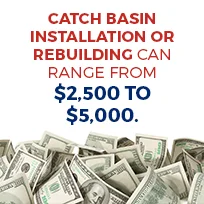 Depending on what goes wrong with a catch basin or the conditions under which one is installed, installation or rebuilding costs might range from $2,500 to $5,000. Catch basins suffer from many of the same problems as dry wells do, including incorrect installation and generally being undersized for the job. The constant nature of the freeze-thaw process can also cause damage to the concrete parts of your catch-basin system and then allow water to percolate, flow and otherwise escape.
Depending on what goes wrong with a catch basin or the conditions under which one is installed, installation or rebuilding costs might range from $2,500 to $5,000. Catch basins suffer from many of the same problems as dry wells do, including incorrect installation and generally being undersized for the job. The constant nature of the freeze-thaw process can also cause damage to the concrete parts of your catch-basin system and then allow water to percolate, flow and otherwise escape.
Once the concrete or asphalt materials sustain some kind of damage, they must be repaired or removed and replaced in order for the basin to function correctly. The extent of repairs depends entirely on each individual situation, but they normally require professional expertise for a number of tasks:
- Saw or cut away concrete
- Remove the entire basin frame and grate
- Take out part of the frame
- Mix and apply repair mortar
- Mix and apply sealant mortar
- Seal any saw cuts with rubberized, moisture-proof material
Installing or repairing a catch basin also requires many of the same trench-digging and pipe-attachment tasks as a dry well, which involve knowledge of the slope, soil, system capacity and water characteristics, at a minimum.
French Drains as a Complement

As you seek to install, repair, service or maintain the drainage utilities around your home, you may encounter the term French drain used either correctly or incorrectly. While some people refer to it as the basement dewatering system or interior foundation-drainage system, a French drain is the outdoor, buried drain line that carries water away from the home. It often runs to a dry well or seepage pit located about 15 feet or more from the building.
Where the Water Flows
Dry wells and catch basins alike can be a help to the surrounding environment if they’re installed correctly and work right but can be a detriment if they clog or malfunction. It seems so natural to let water flow to where it will, but the various utilities are there to aid nature in filtering out some of the harmful elements that flow in and to water, including:
- Animal waste
- Human waste
- Garbage
- Various chemicals
- Soil and fine particulate matter
- Plant fertilizer
- Weed killer
The laws and other regulations in place to mandate clean water not only aim to protect water but also to spread awareness about how clean water and responsible drainage practices are up to each individual who owns some kind of property. The onus is on the landowner to correctly install and then maintain drainage systems including catch basins, dry wells and septic systems. Different government entities regularly test all forms of water including coastal areas, lakes, rivers, groundwater and water tables and aquifers.
When one of them shows distress such as pollution, increased temperature or dead fish, it usually launches an investigation to find the source of the problem, and anyone contributing to it can be subject to fines, penalties and repair or restoration measures. From big chunks of debris to small, unseen chemicals, the concern for clean water comes through local agencies directly from the Environmental Protection Agency.
Federal Suggestions Relate
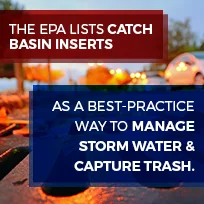 One of the EPA’s charges is to study and research how best to distribute the water society uses, ultimately without any harm to the supply or environment. The agency lists ways to prevent debris and the garbage that blows around from entering storm and sewer drains. Among these tips is using catch basins with accessories such as hoods, screens and fabric inserts.
One of the EPA’s charges is to study and research how best to distribute the water society uses, ultimately without any harm to the supply or environment. The agency lists ways to prevent debris and the garbage that blows around from entering storm and sewer drains. Among these tips is using catch basins with accessories such as hoods, screens and fabric inserts.
A curb hood can prevent excess debris from entering the storm drain. A screen installed inside the catch basin can also prevent trash from entering and accumulating in the system, including outlet pipes or other features. Those with a mesh size of at least 5 millimeters are considered by EPA to be “full-capture devices.”
The EPA also lists catch-basin inserts as a best-practice way to manage stormwater and capture trash. It can be a fairly easy and inexpensive way to augment an older system or set up a new one since it is usually placed where the basin discharges and features a steel-frame insert with durable fabric-filter material that can handle high flows and debris load.
As the analysis of water bodies and supply continues, many are found to have concerns for one or several reasons, and that ratchets up the need for individual conscientiousness about water, drainage and waste. The EPA’s sections on trash and floatables state, "Over 200 individual water-body reaches...have been listed for trash, debris or floatables since 1996." Those water-body reaches include Alaska, California, Connecticut, the District of Columbia, Hawaii, Maryland and New York, and the “listed” status indicates that they are compromised in some way.
When a water body or supply is found to be compromised, the responsible agencies will take action to correct the problems, which often includes legislation, public-awareness campaigns and further water analysis. One measure seen more in urban areas is where neighborhoods adopt a section of storm sewers, catch basins or retention ponds in order to better maintain them.
Consult an Expert Partner
Mr. Rooter of Greater Syracuse provides the full range of expertise and skills needed to assess, install, repair and maintain any kind of dry well or catch-basin system. Our specialists are licensed plumbers certified by Onondaga County for plumbing leak detection or any plumbing-related project in a residential or commercial setting, and we are familiar with the applicable regulations in the Syracuse-Oneida local area as well as state and other rules.
Whether you suspect a problem, already have an issue or want to know how you can better maintain any part of your water usage or drainage system around the house, call Mr. Rooter to have a professional visit your home and perform a plumbing check-up at no charge. Ultimately, better maintenance and upkeep saves you money over time since it prolongs the life of your system and helps prevent breakdown.
This general check of the system provides you with an assessment of its performance and will help discover any issues or problems. Almost always, it’s best to find and fix problems sooner rather than later, since they can worsen over time and incur even costlier repairs. Even if you have no concerns about your dry well or catch basin, an initial inspection of it provides a performance baseline you can use to assess its future performance.


